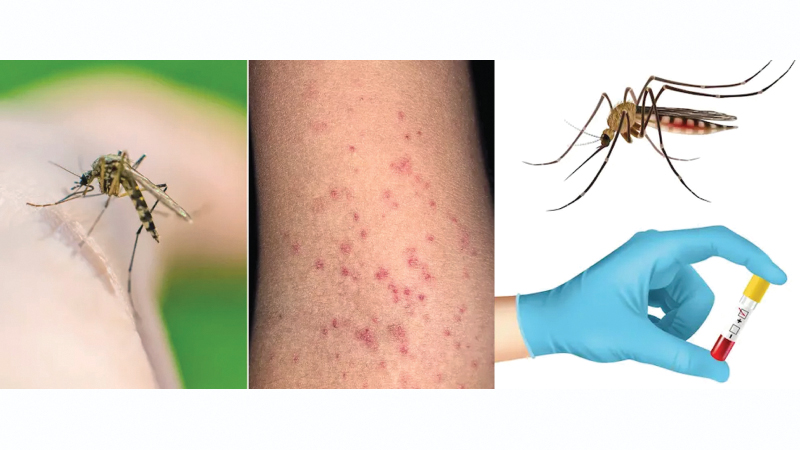 The recent dengue outbreak in Sri Lanka has led to a sharp rise in the number of patients afflicted by the more severe forms of the disease who could easily succumb to these symptoms if they were not admitted immediately to the nearest hospital Preferably one with a well equipped ICU for treatment. Unfortunately this is not always the case with parents and guardians often delaying to take the patient to hospital for various reasons despite the fact that every minute counts as the disease progresses. Tragically many whose lives might have been saved with early hospitalisation are also in the prime of their lives or infants whose lives have only just begun.
The recent dengue outbreak in Sri Lanka has led to a sharp rise in the number of patients afflicted by the more severe forms of the disease who could easily succumb to these symptoms if they were not admitted immediately to the nearest hospital Preferably one with a well equipped ICU for treatment. Unfortunately this is not always the case with parents and guardians often delaying to take the patient to hospital for various reasons despite the fact that every minute counts as the disease progresses. Tragically many whose lives might have been saved with early hospitalisation are also in the prime of their lives or infants whose lives have only just begun.
The Sunday Observer spoke to one of Sri Lanka’s best known authorities on dengue and Dengue HaemorrhagicFever (DHF), Founder Clinical Head for Clinical Management of dengue and Dengue Haemorrhagic Fever and currently Consultant Paediatrician Nawaloka Hospital, Negombo, Dr. Lakkumar Fernando on how to close the gaps that lead to the preventable fatalities and morbidity caused by severe dengue and the urgent need to raise awareness on this topic among the public in general in an online interview.

Dr. Lakkumar Fernando
Q: I understand that dengue can lead to more serious forms which could even be life threatening. While most persons are aware of the milder forms of the disease many are still in the dark with regard to these severe forms of the disease, and seek treatment only when they are unable to bear the extreme discomfort they feel as it progresses. What are they?
A: According to WHO, one in 20 patients with dengue can develop severe disease. Severe disease includes shock and breathing difficulty due to severe plasma leak, Massive Bleeding and Multi organ involvement with failure. In this group death rates are high. Once in hospital the treatment is not always easy for someone who is in shock or impending shock. The treatment itself can lead to fluid overload.
Q: What are the main causes of death in dengue?
A: Prolonged shock, fluid overload and massive bleeding are the 3 main causes of death.
Q: I understand that it can trigger myocarditis like some viral diseases. True or false?
A: Viral Myocarditis is a well known separate disease entity, but whether the Dengue Virus is one of the causes is still not well established. The term ‘itis’ suggests inflammation and one should be able to prove it histologically to confirm. To call it ‘Dengue Myocarditis’ microscopically visible changes should be present in myocarium. Over the years though many post mortums have been done on dengue deaths world over, there aren’t enough credible histologically proven myocarditis to declare ‘Dengue myocarditis’ as a definite entity. However transient generally non fatal cardiac effects like rhythm disturbance are known in dengue.
Q: How do you differentiate severe dengue symptoms with normal dengue?
A: Fever is an essential symptom in 99 percent or more and measuring it with a thermometer is the best way to be sure. Normal temperature is 37 centigrade or 98.6 Fahrenheit. In dengue it’s usually above 38C or 100+ F Fahrenheit. Severe headache, pain behind eyes, generalised body aches with muscle and joint pains are common.
The above are common to many and some will have nausea, vomiting and abdominal pain. However if the disease is allowed to progress without treatment many more symptoms like severe abdominal pain or persistent vomiting, faintishness, shock all can develop.
Q: Could you please elaborate?
A: The severe symptoms occur more in those who develop a condition called Dengue Haemorrhagic Fever ( D H F ) where there is a period of plasma leaking from tiny blood vessels called capillaries in the abdominal and pleural spaces in the lungs. This could lead to shock and death. In some people due to a number of reasons the leaking can be extensive and rapid, but it’s consistently limited to the abdominal cavity and pleural spaces. Others can have severe bleeding in addition with or without leaking.
Q: Can certain drugs trigger these symptoms or aggravate them? If so, name a few.
A: Severe bleeding is often triggered by NSAIDS like ibuprofen, mefanemic acid or diclofenac sodium or Steroids like prednisolone, dexamethasone given to control fever and aches. These drugs should never be used to control fever in patients living in dengue endemic areas. Currently most dengue deaths are related to the use of these drugs, either through self medication or given by few careless doctors.
Q: What are the symptoms known as ‘warning signs’ in dengue?
A: Severe pain and tenderness of abdomen, persistent vomiting, lethargy and restlessness, postural hypotension (fainting in getting up), liver enlargement and accumulation of fluid in chest and abdomen were classified as “Warning signs” by WHO in 2009. However most of these are evidence of too far progressed disease due to inadequately treated plasma leaking of dengue than “truly useful early warning signs” that could consistently help reduce and severe complications.
Fifteen years on from their introduction of the ‘warning signs of 2009 WHO Dengue Guidelines, they appear both inconsistent and less helpful in bringing down death rates in Dengue. Countries like Sri Lanka that did not follow these 2009 WHO classification treatment guidelines of acting, waiting for those warning signs, has done better than many countries that followed this classification. Treatment interventions should begin well before these ‘warning signs’ appear if we are aiming for death rates. It’s good to be proactive than reactive.
Q: How has Sri Lanka performed over the years with dengue?
A: From the rate of reductions of deaths due to dengue Sri Lanka has performed better than almost any country in the world due to better treatment practices though the case numbers have not significantly gone down as prevention is not easy.
Q: Can anyone become afflicted by these extreme forms of the disease?
A: Theoretically yes. A person can develop dengue four times during their lifetime. Usually the first time is mild or asymptomatic. The second time is likely to be more severe than any other time. The third and the fourth are usually less severe than the second time. Sometimes improper treatment can turn mild disease into a severe level.
Q: Age-wise who are those most at risk of developing severe disease in an environment where the dengue virus as well as other infectious viruses are circulating freely?
A: Adolescents and young adults in a dengue endemic area are more likely to be those with second time Dengue and possibly are more likely to theoretically develop on the basis of their exposure.
Out of those who develop dengue the very young children and infants, the elderly and those with other conditions like obesity, diabetes or liver disease are also at a higher risk of developing complications and more severe dengue.
Q: What are the main signs to look out for in each of the following cases: 1) Very young children like toddlers? 2) Primary school children? 3) Pre adolescents 4) Young people in their twenties and thirties?
A: For all, the most important sign to look out for is fever which is moderate to high in a large majority. Once you have documented fever, it’s best to get a Dengue Rapid Test done and follow up with daily FBC. If platelets are dropping fast lower than 100,000 any person irrespective of age can be a potential candidate to develop the severe form known as DHF(Dengue Haemorrhagic Fever) it’s best to get admitted to hospital for closer monitoring as our aim should be Dengue a zero mortality disease. Many of those who die of dengue are the ones who were waiting at home for too long advised by others to wait until more signs or more warning signs develop.
Q. What about infants and newly born babies? Are they also vulnerable to getting dengue in an unhealthy surrounding?
A: It’s surroundings with exposure to the mosquito through a bite that matters for any age when it comes to dengue.
Q: So what are the signs that a mother or caregiver must look out for in such young children given the fact they are unable to express themselves and articulate their discomfort ? Sunken eyes? Cool discolored hands and feet?
A: The ones you have described are late signs of severe disease showing shock or impending shock and one should never wait till those develop to go for medical care. Fever or history of fever with less activeness or lethargy, refusing feeds, vomiting, reduced urine output are some of the signs that you may be heading for severe disease
Q: How do you measure the urine passed by a baby to know if he/she has a severe form of dengue?
A: In a baby the number of times they pass urine, the frequency of wetting their pants or pampers (though the wearing of pampers while at home for the convenience of today’s parents should be discouraged). For bigger children and adults, they should pass as urine, at least half the volume they drink if they are well hydrated. While in hospital when the disease is severe, careful fluid therapy with relatively tight control may be needed.
Q: Are pregnant women infected by the dengue virus also at risk ?
A: Yes. Especially, towards the latter part of pregnancy.
Q: What are the likely adverse consequences on the mother and the baby as the virus progresses in her body?
A: During the early part of pregnancy, the abortion risk is more. There are no significant congenital malformations linked to dengue as such. The virus could be transmitted to the baby during the very end of pregnancy though.
Q: A study abroad says that the risk of neurologic congenital anomaly in the infant increases by roughly 50 percent and for other congenital mutations of the brain by four fold. Do you agree?
A: Difficult to believe
Q: To sum up, could you repeat the symptoms of the severe forms of dengue?
A: Those with Dengue Haemorrhagic Fever (DHF)is the group of patients who develop transient plasma leaking through capillaries in the pleural and peritoneal spaces. Depending on the degree of leaking leading to blood volume loss (plasma volume loss) the patient’s blood pressure can drop. There are 4 degrees of DHF known as Grade 1, 2, 3, 4 leaking ranging from mild to severe. DHF Grade 3 and 4 are called Dengue Shock Syndrome. DHF Grade 4 where pulse and blood pressure are not detectable is profound shock. DHF Grade 3 is impending shock.
Q: What are the body organs that are most affected by severe dengue?
A: Liver, Kidneys, and gut with bleeding into gut being common. If there is a prolonged period of shock where blood supply to several organs is affected and the patient will end up in multi organ failure.
Q: Does it lead to the entire body shutting down eventually?
A: Yes
Q: When do patients go on to develop the severe forms of dengue ? I was told that it is around the time the fever has begun to subside, usually 3-7 days after the symptoms with the added complication of serious bleeding and drop in blood pressure (shock ) and death?
A: As described earlier severe disease occurs with plasma leaking. Leaking can start any time from day 2 to day 7 but commonly from day 3 to 6. This happens in many but not in all when the fever is settling. One of the reasons patients may stay at home thinking that the illness is now over with the fever settling. In dengue, settling of fever between 3 to 7 days does not suggest that the patient is now getting better.
Q: Will giving patients’ steroids aggravate their symptoms?
A: Bleeding is often consequent to the use of NSAIDS or Steroids that can cause stomach erosions and ulcers from which there can be massive bleeding the low platelet counts will contribute to the bleeding.
Q: So when a patient starts such symptoms what should be done?
A: Immediate hospitalisation. ICU will only be needed if the resuscitation fails or the prolonged shock has caused failure of several organs. A platelet count, even below 20,000 is not an indication to admit the patient to ICU. Management at ICU will be costly and they should be reserved mostly who will need respiratory assistance through ventilators
Q: What about patients who require special attention when being rushed to a hospital for treatment? Like those with pre-existing conditions likely to worsen or pregnant mothers for example ?
A: Yes, but when clinicians are familiar with treatment, hospitalisation can give most of these patients guaranteed attention.
Q: Are patients with obesity and diabetes melitus as well as those with severe cardiovascular conditions and Chronic Pulmonory Disease ( COPD) also at higher risk than others?
A: Yes of course
Q: Before taking the patient to hospital are there certain Do’s and Don’ts that should be followed?
A: Hydrate by giving them to drink specially electrolyte solutions like Jeevani especially if urine output tests are low. This can be very useful. The most important ‘don’t do’ is using drugs other than paracetamol to control fever.




